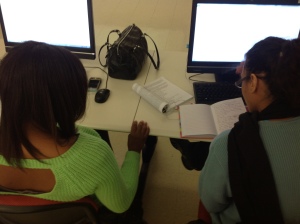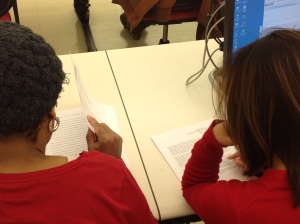The following article was written by retired HWC Professor, Arleen Prairie
The CLASS Measures and Enhances Qualities that Matter in Preschool Education
The Classroom Assessment Scoring System (CLASS) is an observation tool that focuses on the effectiveness of classroom interactions among teachers and children and classroom organization. From the CLASS research we know children thrive when teachers create nurturing, well-managed settings and engage children in ongoing thoughtful conversations and meaningful activities.
With the overarching goal to improve outcomes for young children, the CLASS provides valuable individual feedback to programs and teachers. This system is successful in
- Program monitoring
- Professional development
- Teacher preparation and education
- Research and evaluation
I am involved in both classroom monitoring and professional development of preschool teachers. Within Chicago Head Start I have assessed preschool classrooms using CLASS, and will continue using CLASS in Head Start Reviews around the country. I find this tool very successful in measuring qualities that matter most in early education: the quality and type of interactions between teachers and children.
During the 2010-2011 school year, I, along with nine other mentors, have the opportunity to coach individual teachers in the Chicago Head Start programs assessed last year. Developed by CLASS, My Teaching Partner involves a positive individualized approach based on recognizing and enhancing the skills of teachers seen through the lens of CLASS.
The CLASS has a definite place in teacher preparation such as at CCCECE. Students in teacher preparation programs can better prepare for teaching with the knowledge of teaching components that really matter for their young students. Some uses of CLASS appear in teacher education courses and training of pre-service teachers. Two institutions are currently implementing these at 1) the Center for the Advanced Study of Teaching and Learning at the University of Virginia (the home of research and ongoing development of CLASS) and 2) the University of North Carolina at Greensboro. Look for reports of implementing CLASS in teacher education soon in www.teachstone.com early childhood journals.
The extensive research on CLASS in the United Sates shows astounding differences in child outcomes. (see Link to article) The CLASS is but a tool, yet one that can effectively enhance the abilities of early childhood educators because of our heightened understanding of what benefits the present and future of our young children.
The Basis for CLASS: Effectively Improving Teacher-Student Interactions
By Arleen Prairie
We have the potential to make a difference in our young children’s lives by investing in this research-based tool to help teachers and schools to improve the quality of their instruction. When we identify and measure effective interactions we can create opportunities to promote them through teacher education and professional development.
Research
In Pre-K through 3rd grade, children in classrooms with higher CLASS ratings realize greater gains in achievement and social skill development. The link between effective interaction and improved social and academic outcomes for children has been replicated in numerous studies. Furthermore, higher levels of instructional support are related to preschoolers’ gains in pre-reading and math skills.1 The effective teacher student interactions that most impact young children’s learning shows up in the extensive literature review, research and extensive piloting used to develop and define CLASS at the University of Virginia.1
As teachers increase their competencies, they become more effective teachers, experience greater job satisfaction and remain in the teaching field. Most importantly, more effective teacher-student interactions and improved outcomes lead to enhanced outcomes for children—children lean more and develop the skills necessary for future achievement.1
Unfortunately, too few children are exposed to the types of effective interactions in the preschool and early grades. In a study of 700 preschool classrooms across 11 states, less the 15 % of classrooms were observed to display moderately to highly effective teacher-student interactions across all three categories. Moreover, effective interactions are highly variable form year to year. In a study that followed 800 students from the first to the fifth grade, less than 10% of children were consistently enrolled in classrooms that scored in the mid- to upper range for effective interactions.2 Significantly, children from low income families are less likely to experience effective teacher-student interactions, relative to middle-income peers.2
For children at risk for school failure, the component of emotional support can carry significant importance. For example, among a group of students who displayed significant behavior and emotional problems in kindergarten, those who were placed in first-grade classrooms offering high levels of emotional support made academic progress at levels similar to the low-risk peers, whereas high-risk students placed in classroom offering lower levels of emotional support fell further behind their low-risk peers.3
CLASS Domains, Dimensions and Teachers’ Learning
The CLASS focuses on three broad domains of interaction known to contribute to children’s success in school:
Emotional support: Positive relationships among teachers and children
Classroom Organization: Well-managed classrooms that provide children with frequent engaging learning activities
Instructional Support: Interactions that teach children to think, provide ongoing feedback and support, and facilitate language and literacy development.1
Each of these broad categories is further defined in multiple dimensions which highlight significant characteristics of the domain.
Within the domain of Instructional Support, the two dimensions of Concept Development and Quality of Feedback statistically score low across all the results. Out of a 7 point scale, these two dimensions each have a mean of 1.6. In comparison, the other dimensions score a mean of 4 (or slightly lower).4 In gaining an understanding of these two dimensions we can use their descriptors to inform us ways to enhance these in teacher education and professional development.
First, Concept Development involves the discussion around the ideas and activities that promote higher-order thinking skills which leads to understanding concepts rather than rote learning. These skills include analysis and reasoning, problem solving, creating and generating children’s ideas. Also, children can link new understanding to previous learning and real life situations. The discussions encompass how children can approach a problem or relate what they know to a new concept. For example, as the classroom teacher prepares to cut an avocado with a small group of children, he says, “I remember when we cut the apple in two. I wonder what we will find inside the avocado.”
Understanding concepts continue within the focus of Quality of Feedback through interactive participation of individual children and groups. As children conceptualize, instead of simply providing answers, the teacher assists the child through supportive prompts, such as in scaffolding, Sometimes the teacher supplements the child’s response, or requests an explanation to their thinking. For example, when the child answers a question, instead of saying, “Good job,” the teacher may ask,” How did you know that?” As these back and forth questions and explanations continue, this specific feedback elicits deeper understanding by helping children communicate their ideas and assisting others in processing the concepts under discussion.
Teachers appreciate expanded outcomes of Concept Development and Quality of Feedback through using the invaluable feedback in My Teaching Partner, the CLASS approach to professional development, Teachers can value the effective interactions they implement, evaluate the skills they see changing in their training and grasp the importance of enhancing these skills even more in their work.
Teachers hold to the high standards of CLASS when they experience the children’s eager engagement in learning as a result of the emotional support, classroom organization and instructional support. This realization strengthens their teaching.
End Notes
1 Robert Pianta. (4/2009). “Effective Teacher-Student Interactions: Measuring and Improving Classroom Practice.” www.fcd-us.org
2 Robert Pianta, Jay Belsky, Renee Houts, Fred Morrison, and NICHD-ECCRN, “Opportunities to Learn in America’s Elementary Classrooms,”
Science, 315, pages 1795-1796.
3 Bridget Hamre and Robert Pianta, “Can Instructional and Emotional Support in First Grade Classrooms Make a Difference for Children At
Risk of School Failure?” Child Development, 76, pages 949-967.
4 Notes from CLASS Training, September, 2009, Chicago.












